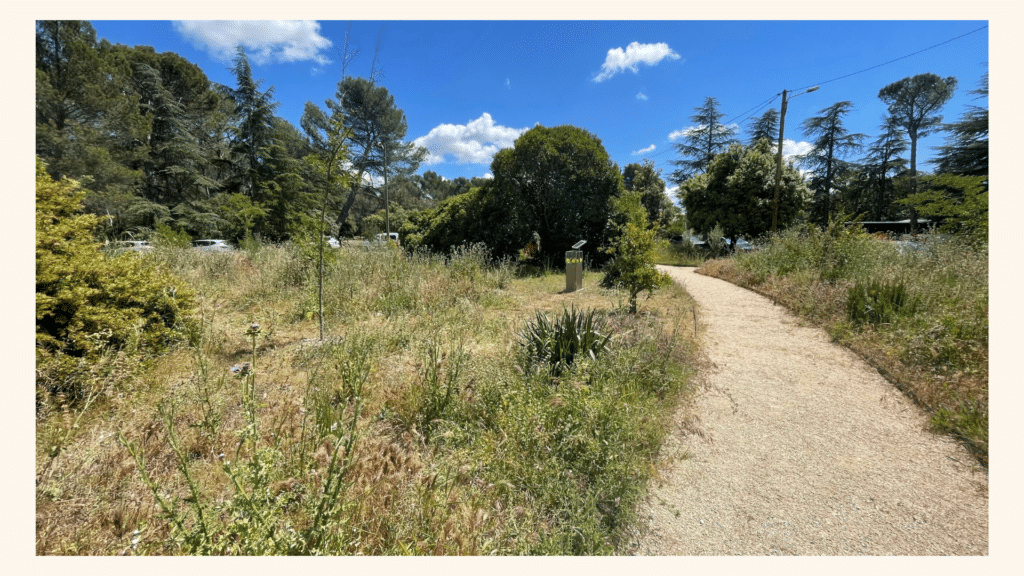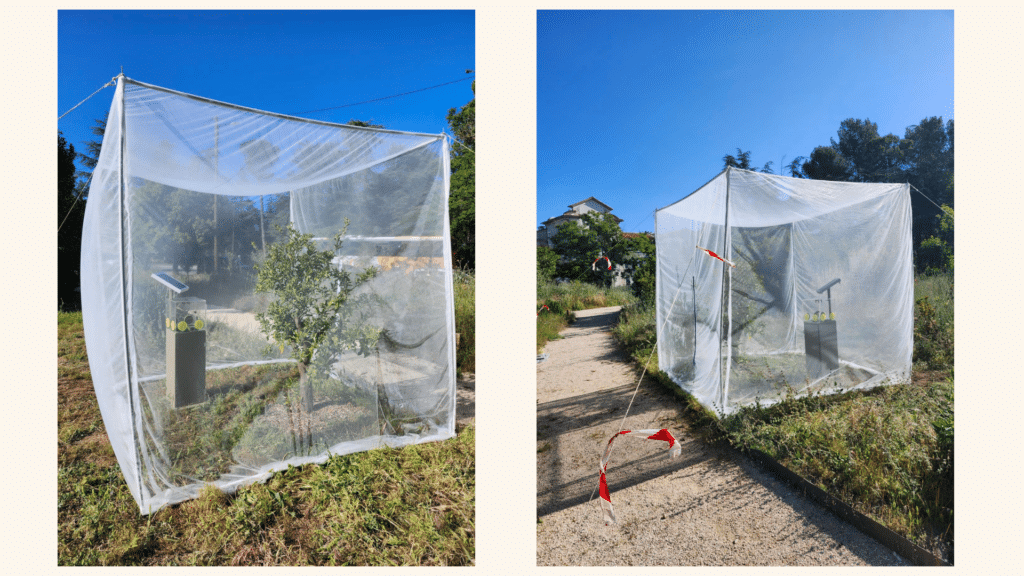On September 28, 2023, we had the pleasure of inaugurating our orchard located in the heart of the Technopôle de l’Arbois in Aix-en-Provence. This orchard, a true showcase of our sustainable and natural solutions, represents a significant milestone in the development of Cearitis, our startup specializing in research and development (R&D) in biocontrol and agroecology.
One year after this inauguration, we take this anniversary as an opportunity to reflect on the progress made during the first year of operation. Our orchard has not only demonstrated the effectiveness of our innovative solutions but has also become a meeting and testing ground for local players in ecological innovation.
What is Cearitis’ Orchard?
Spanning 2,700 m², our showcase orchard is home to a wide variety of fruit trees. You’ll find citrus trees such as lemon, mandarin, and orange trees, as well as cherry, peach, apricot, almond, and, of course, olive trees.
To promote agroecological practices among a wide audience, we have installed various structures such as compost bins, an insect hotel, bat houses, and bird nesting boxes. Additionally, flower strips have been planted to encourage biodiversity and improve water infiltration into the soil. We’ve also introduced specific host plants to attract parasitoids, natural allies in the fight against the olive fruit fly.

Asphodel, Marigolds, and Alyssum
We’ve installed a trail camera, a valuable tool that has revealed the rich diversity of the orchard and its surroundings in terms of wildlife. Among the species observed are a protected natterjack toad, rabbits, a family of fifteen wild boars, and foxes (some with striking black socks). The camera also captured images of green woodpeckers, finches, tits, and even red-legged partridges. Among the insects, we observed a variety of species, from praying mantises and large green grasshoppers to radiated tarantulas and sulfur owlfly.
Our biodiversity-rich orchard continues to thrive, thanks to agroecological practices.
Agroecological Practices
Our agronomist has implemented several agroecological practices to protect and preserve our orchard. First, she maintains a permanent grass cover in the orchard. By keeping the vegetation cover, we protect the soil from erosion caused by wind and the occasional but intense rains. In spring, to reduce competition with the fruit trees and avoid water and nutrient stress, we performed partial mowing. This method allows us to maintain a protective vegetation cover while limiting competition for nutrients with the fruit trees. Partial mowing also helps retain soil moisture and promotes biodiversity by creating habitats for beneficial organisms and other small animals. Located in the PACA region, characterized by intense sunlight and insufficient rainfall, these practices are particularly crucial. Regular mowing and annual tree pruning help limit humidity within the foliage, which can lead to fungal diseases. These measures, adapted to our specific climate, demonstrate our commitment to using sustainable agricultural techniques to ensure the health and resilience of our orchard despite the environmental challenges of our region.

Partial Mowing of the Cearitis Orchard
In terms of water management, we’ve implemented a controlled irrigation system based on careful monitoring of the health of our trees and continuous tracking of soil moisture at different depths, using capacitive sensors provided by our partner. This technology allows us to precisely adjust our water supply, avoiding water stress for the trees while optimizing the use of this precious resource. Through this approach, we manage to conserve water while ensuring the health and productivity of our orchard.
Additionally, we observed aphid attacks on a cherry tree and almond leaf gall mites on our almond trees. To prevent an increase in pest pressure, we opted for a single treatment with black soap. This natural and environmentally friendly solution helps control aphid and gall mite populations without using chemical pesticides. Black soap works by washing away the honeydew produced by aphids, while preserving beneficial insects and minimizing the impact on the orchard’s ecosystem. This treatment is part of our integrated pest management strategy, aiming to maintain an ecological balance while protecting our fruit trees.
The orchard’s beneficial insects also assist us: this is conservation biological control. We see this on the trees with the presence of parasitized aphids and ladybug larvae. By regularly monitoring our crops and intervening in a targeted manner, we succeed in reducing infestations without harming biodiversity. Moreover, this approach allows us to enhance the natural resilience of our orchard against future attacks by encouraging the presence of natural allies like ladybugs and hoverflies, which feed on aphids.
By combining agroecological practices with natural solutions, we demonstrate our commitment to sustainable and environmentally friendly agriculture, ensuring the health and productivity of our orchard for years to come.
An Experimental Space
This showcase orchard is not just a demonstration space but a living laboratory where innovation meets environmental respect. Recently, our orchard has been used by our chemistry experts and entomology engineers to conduct semi-natural condition tests on the Mediterranean fruit fly, “Ceratitis capitata“. This year marks the beginning of our intensive research on this pest, which affects over 250 fruit varieties.
Our team conducts tests directly on the plot. They set up an experimental cage containing a tree of the crop to be protected, our trap, and release a hundred “Ceratitis capitata” individuals. At the center of the cage is a tree of the crop to be protected, currently a mandarin tree, to closely mimic the real conditions encountered by growers. The goal is to test the effectiveness of our first specific attractant for this fly, as well as the trap designed to capture it, for an increasingly refined biocontrol solution.

PIRA® Trap in the Cearitis Orchard
These experiments aim to evaluate and improve the performance of our solution under near-natural conditions. Outdoors, we can observe the insects’ behavior more accurately and adjust our formulations to maximize their attraction and capture. This rigorous method ensures that our products offer reliable and long-lasting protection against this major pest once they reach the growers.
Using our orchard for these tests underscores our commitment to innovation and applied research. By developing effective and environmentally friendly solutions, we contribute to pest control while minimizing the impact on local ecosystems. This integrated and scientific approach strengthens our position as a leader in creating sustainable solutions for the agriculture of tomorrow.
A Place for Exchange
The showcase orchard is also a space for enriching exchanges. Throughout this first year, the orchard has hosted a series of educational events aimed at raising awareness among people of all ages about the importance of sustainable agriculture. From educational workshops to agronomic monitoring demonstrations, each activity was designed to share our expertise and inspire a new generation to protect biodiversity.
We were also honored by visits from many key local stakeholders, including deputies, senators, and investors, who contributed to fruitful discussions on best agricultural practices and future challenges. These interactions not only strengthened our ties but also highlighted the need for cooperation to foster innovation and adopt eco-responsible farming methods.

From left to right: High School Students with Our Agronomist, Chloé Ribard, and ESSCA Students with Our Marketing & Communication Manager, Mélissa Benon
By regularly opening its doors during presentation days, the orchard allowed a diverse audience to explore its facilities, discover its biodiversity, and engage directly with our agronomists. These moments of sharing and discussion are essential for building lasting relationships and encouraging a more respectful approach to agriculture.
As we mark the first anniversary of our showcase orchard, we celebrate a fruitful year, rich in discoveries and collaborations. This project perfectly illustrates our commitment to agroecology and biodiversity while strengthening our connection with the local community.
With the olive harvest approaching, we invite you to explore our article on the fascinating olive lifecycle.